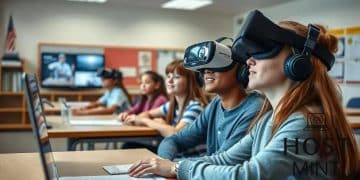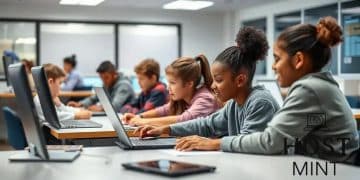Growth of bilingual education programs in US schools

The growth of bilingual education programs in US schools enhances cognitive skills, improves academic performance, and fosters cultural awareness, addressing the diverse needs of contemporary classrooms.
The growth of bilingual education programs in US schools is a significant trend worth exploring. This evolution not only enriches students’ linguistic skills but also enhances cultural awareness. Have you wondered how this impacts your community?
Understanding bilingual education programs
Understanding bilingual education programs is essential in today’s diverse classrooms. These programs are designed to help students learn in two languages, which can greatly enhance their learning experience. As we explore this topic, it becomes clear how bilingual education is shaping the future of schooling in America.
What Are Bilingual Education Programs?
Bilingual education programs focus on teaching students in their native language while introducing them to English. This approach has numerous benefits, including:
- Improved language skills in both languages.
- Enhanced cognitive development.
- Cultural awareness and appreciation.
- Better academic performance.
These programs can include a variety of models, such as dual-language immersion, transitional bilingual education, and more. Each method aims to support and maintain a student’s native language while promoting English proficiency.
Benefits of Bilingual Education
The benefits of bilingual education are multi-faceted. First, students become proficient in both languages, allowing them to communicate effectively in a globalized world. Secondly, they develop critical thinking skills by navigating between languages.
In addition, bilingual education fosters a greater understanding of cultural differences. When students learn from a bilingual perspective, they gain insights into different customs and traditions, making them more socially aware.
Moreover, research shows that bilingual students often outperform their monolingual peers in standardized tests. This advantage stems from the enhanced cognitive flexibility that comes with learning multiple languages.
Challenges of Implementing Bilingual Programs
Despite the advantages, implementing bilingual education programs can be challenging. Some issues include:
- Insufficient funding for materials and training.
- Resistance from parents and school staff.
- Lack of qualified teachers fluent in both languages.
These hurdles can hinder the effectiveness of programs and limit their outreach. However, communities that support bilingual education can overcome these challenges through advocacy and collaboration.
Ultimately, bilingual education is crucial for the development of students in today’s interconnected world. Understanding and promoting these programs can lead to a richer, more inclusive educational experience for all.
Benefits of bilingual education in schools

The benefits of bilingual education in schools are numerous and impactful. These programs not only promote language skills but also enhance overall student learning experiences. Let’s delve into some of the key advantages that bilingual education offers.
Enhanced Cognitive Skills
Bilingual education strengthens cognitive abilities in students. When learners are exposed to two languages, they develop improved critical thinking and problem-solving skills. This dual exposure fosters creativity and flexibility in their thinking processes.
Academic Achievement
Research shows that bilingual students often perform better in standardized tests compared to their monolingual peers. They are more adept at navigating complex tasks, which translates into higher achievement levels across various subjects.
Cultural Awareness and Sensitivity
Another important advantage is the promotion of cultural awareness. Bilingual programs help students appreciate diversity and different cultural perspectives. This understanding fosters respect and empathy, crucial traits in our global society.
Career Opportunities
In an increasingly interconnected world, being bilingual can significantly boost career prospects. Many employers seek individuals who can communicate in multiple languages. Bilingual education opens doors to a wider range of job opportunities in various fields.
- Increases employability in diverse job markets.
- Prepares students for roles in international relations.
- Enhances competitiveness in the job market.
Overall, the benefits of bilingual education extend far beyond mere language acquisition. They prepare students for success in their academic and professional futures. By promoting bilingualism, schools are equipping the next generation with the skills and knowledge needed in a diverse world.
Challenges faced by bilingual education systems
Bilingual education systems face several challenges that can hinder their effectiveness. Understanding these obstacles is crucial for improving the implementation and sustainability of these programs. Among the most pressing issues are funding, resources, and community support.
Insufficient Funding
One major challenge is the lack of adequate funding. Many schools struggle to secure the necessary financial resources to maintain and develop bilingual education programs. This can result in shortages of educational materials and trained teachers.
Resource Allocation
Proper resource allocation is essential for the success of bilingual programs. Schools might not have access to enough bilingual books, technology, and other materials that are necessary for a comprehensive learning experience. When resources are limited, the quality of education can suffer.
Community and Parental Support
Another significant challenge is gaining support from the community and parents. Some families may not understand the benefits of bilingual education or may prefer traditional education methods. This lack of support can lead to decreased enrollment in bilingual programs, creating fewer opportunities for students.
Additionally, some educators may lack the training or confidence to teach in a bilingual setting. This can affect not only the teachers’ performance but also the students’ engagement and learning outcomes. It is important for schools to invest in professional development for educators to ensure they are well-equipped to handle the complexities of bilingual education.
- Need for ongoing teacher training.
- Building outreach programs to involve parents.
- Creating awareness about the benefits of bilingual learning.
Finally, political factors can also influence the success of bilingual education systems. Policies regarding language use in schools can change depending on local or national elections. Such shifts can create instability in the educational environment, making it difficult for programs to thrive.
Successful case studies in bilingual education

Successful case studies in bilingual education provide valuable insights into effective practices and positive outcomes. These examples highlight how schools can implement bilingual programs that benefit students and communities.
Example 1: Two-Way Immersion Programs
One effective model is the two-way immersion program, which blends native English speakers with native speakers of another language. In this setting, students learn academic content in both languages. Research has shown that participants in these programs often outperform their peers in test scores.
Example 2: Dual Language Schools
Schools that provide dual language education emphasize equal proficiency in both languages. For instance, a school in California reported impressive results with its dual language approach. Students developed strong reading and math skills while also maintaining their cultural identity. This model encourages parental involvement, leading to a supportive community atmosphere.
Example 3: Transitional Bilingual Education
Transitional bilingual education focuses on helping students transition to English while supporting their native language. In Texas, one school used this method to assist newcomers. They provided resources in both languages, which helped students feel valued and confident. This approach also reduced dropout rates significantly.
- Improved language proficiency in both English and the native language.
- Higher academic performance across all subjects.
- Increased engagement among students and families.
These success stories show that when schools invest in bilingual education, they not only improve academic outcomes but also foster a sense of belonging among students. The positive impact of these programs extends beyond the classroom, enriching the entire community.
Future trends in bilingual education
Future trends in bilingual education are exciting and hold great potential for enhancing learning experiences in schools. With the increasing diversity in classrooms, educators are focusing on innovative methods to support bilingual programs.
Technology Integration
One prominent trend is the integration of technology in bilingual education. Tools such as language learning apps and interactive software provide students with engaging ways to practice both languages. By using these resources, teachers can create a more dynamic learning environment that caters to different learning styles.
Personalized Learning
Another trend is the shift towards personalized learning. Educators are recognizing that each student learns differently. Tailoring bilingual programs to meet individual needs can lead to greater success. This approach allows students to progress at their own pace, enhancing their language skills effectively.
- Adaptive learning technologies that adjust to student performance.
- Customized resources to support diverse language backgrounds.
- Flexible learning pathways for students.
Additionally, there is a growing emphasis on cultural inclusivity in bilingual programs. Schools are incorporating a variety of cultural perspectives into the curriculum. This not only enriches students’ understanding of different cultures but also fosters a sense of belonging and respect for diversity.
Collaboration with Families
Another trend is increased collaboration with families and communities. Schools are actively seeking ways to involve parents in their children’s bilingual education. Open communication and family engagement enhance the learning process and reinforce the importance of language and culture at home.
Finally, we can expect a greater focus on policy support for bilingual education. Advocates are pushing for legislation that recognizes and funds these programs more effectively. As society continues to understand the benefits of bilingualism, we can look forward to a more robust framework for supporting bilingual education in the future.
FAQ – Frequently Asked Questions about Bilingual Education
What are the main benefits of bilingual education?
Bilingual education enhances cognitive skills, improves academic performance, and fosters cultural awareness among students.
How does technology impact bilingual education?
Technology integration allows for personalized learning experiences, making it easier for students to engage with both languages through interactive tools.
What challenges do bilingual education programs face?
Challenges include insufficient funding, lack of resources, and the need for greater community and parental support.
What future trends can we expect in bilingual education?
Future trends include increased technology use, personalized learning approaches, and a stronger emphasis on community involvement and policy support.






